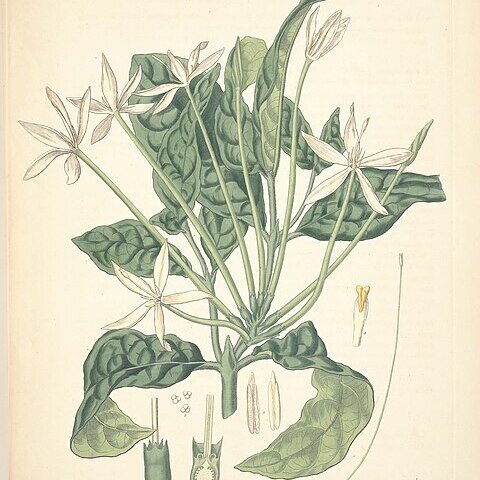Inflorescences only one per node on alternate sides at successive nodes (see TAB. 75/6) and 1 per branch or 1–several per branch for each season’s growth, lax or contracted, of elongate (catkin-like when very young) or corymbose panicles; bracts/bracteoles lanceolate to narrowly ovate or filiform to subulate from a triangular base; peduncles short; bractelets similar to bracts but smaller or absent.
Ovary 1–2-locular, but the 2 locules ± confluent, the 2 placentas joined only at the extremities; ovules very numerous, not immersed within the fleshy placentas; style very slender, glabrous; pollen presenter exserted, small club-shaped or fusiform, bearing 2 stigmatic lips at its apex.
Leaves petiolate; domatia often present as tufts of hairs in the nerve axils or as lines of hairs along the midrib just above and/or below the nerve axils; stipules green in the dry state, usually somewhat coriaceous, erect, persistent, sometimes ± connate at base.
Stamens fully or partly exserted, attached within the throat; anthers sessile or subsessile, apiculate or with an acuminate appendage at apex, sometimes prolonged at the base into sterile appendages; pollen grains in tetrads.
Seeds usually free but sometimes held together with placental tissue, compressed-ellipsoid, quite large, 4–8 mm long; testa ornamented with concentric horseshoe-shaped to fingerprint-like striations.
Shrubs, small trees or occasionally dwarf single-stemmed shrubs, rarely rhizomatous, the vegetative parts often sweet-scented in the dry state.
Corolla white; tube very narrowly cylindrical, the throat glabrous to sparsely pubescent; lobes narrow, contorted, overlapping to the left.
Calyx tube turbinate to ellipsoid or somewhat cylindrical; limb-tube short to long; lobes usually narrow.
Fruit globose, ellipsoid or fusiform, ± fleshy in life, sometimes crowned with the persistent calyx limb.
Flowers hermaphrodite, 5-merous, subsessile to pedicellate.
Disk annular.

